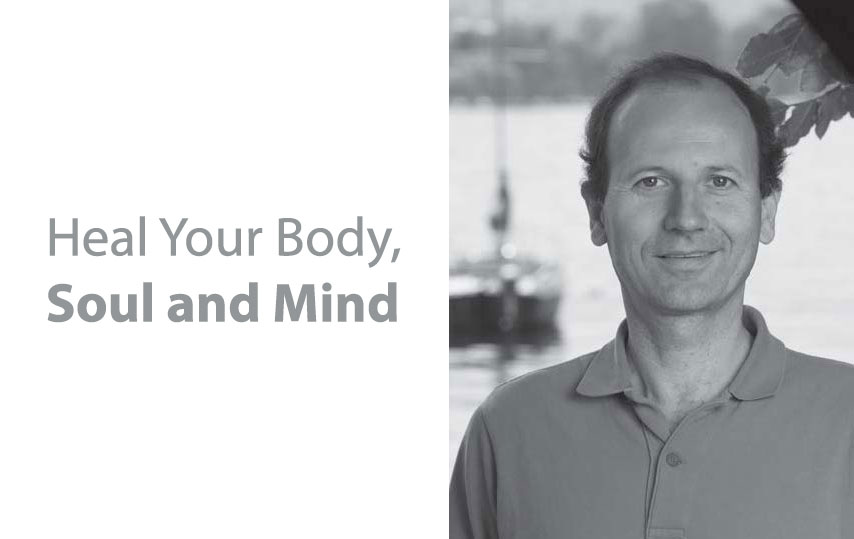In 2011, Remo published The Big Book of Yoga Therapy in Germany. The English edition has also been recently launched. Asana (“A”) interviewed Remo (“R”) on his project.
A: Proponents of Yoga often describe its therapeutic effect. As a Yoga therapist, what is your experience?
R: Yoga is the connection with the universal power of self-healing which we can see in nature and in all beings. Practising Yoga independently gives us the chance to help ourselves. Accepting our complaints opens up space for self-reflection and new ways of dealing with them to support our capacities for self-healing. An important point in teaching Yoga is to create the preconditions for a calm and clear mind. Through varied exercises for the body, the breath and the mind, Yoga therapy offers us excellent opportunities to regain peace and clarity.
As a Yoga therapist, I have great trust in this self-healing power. I am always fascinated to observe how people find the answers within themselves when their mind is calm. Connection with a clear mind opens up incredible opportunities for healing and transformation at all levels of being – at physical, emotional and mental needs.
A: Can Yoga therapy cure all kinds of illness or discomfort?
R: My own practical experience indicates that Yoga therapy can be helpful for back pain, neck tension, knee problems, high blood pressure, migraine, digestive complaints, constipation. Asthma, sleep issues, PMS syndrome, cancer, AIDS and many chronic illnesses. This is because Ayur Yoga Therapy recognises the interaction and dynamics between body, breathing, mind, nutrition and way of life, and their effect on the state of our health. In essence, it is less to do with symptoms and illnesses, but more about the causes that have led to the complaint.
A: Could you share some Ayurvedic techniques to deal with chronic conditions?
R: There are no universally applicable Ayurveda tips for chronic complaints and diseases. As the conditions are manifested individually in each person, specific adaptation of the Yoga practice and Ayurveda tips are important for a successful outcome. I have devised some simple and safe programmes to deal with asthma, high blood pressure, to stimulate digestion and encourage emotional stability, and reduce stress. The Yoga practice should compliment internal medicine and remedies, diet and life style.
A: Would you say that simple Yoga postures can achieve therapeutic effect?
R: When we practice Yoga, it is a holistic exercise of physical and mental awareness. If we use a mindset of ambition and achievement to force ourselves into a difficult Yoga posture, we will be unable to reach the quality of stability and ease. In this case, what we are really doing is not Yoga but physical gymnastics. In order to develop a Yoga practice that is healthy and healing, it is essential to keep in mind the yogic approach and the holistic effects on the body, breath and mind.
A: Is this the objective of the Big Book of Yoga Therapy
R: The key objective is to provide readers with the most important foundations of effective Yoga practice. Through combining Yoga with the most up-to-date knowledge of anatomy, I hope to familiarize readers with the healing potential of Yoga therapy. There are many effective Yoga exercises that one can practice with a targeted programme. I hope to motivate readers to practice Yoga regularly and with variety, and integrate the wisdom of Yoga into their lives.

The Big Book of Yoga Therapy is based on the fundamental principles of the Yoga tradition according to the Yoga master, T Krishnamacharya and his pupil, AG Mohan, and on the latest insights in the study of western anatomy. The book is structured clearly, first with the foundations of Yoga therapy, then goes onto Structural Yoga Therapy and Yoga Therapy programmes for chronic complaints. With illustrations, Remo explains precisely the effect of each posture, how to get into the pose, and the breathing patterns. This is a good introduction to those who are interested in the healing potential of Yoga Therapy.
The Big Book of Yoga Therapy is now available for purchase on Amazon.com. A lucky reader will receive a copy of the book upon correctly answering the following questions:
1. What are some of the factors to consider when adapting a Yoga practice to individuals?
a) Age, physical and mental constitution, condition of health, life style
b) Yoga style, relationship, flexibility, needs
c) Religious belief, life style, diet, height and weight
d) None of the above
2. Breath and movement have a healing effect if
a) Movement leads to breath
b) Breath leads movements
c) Movement and breath flow independently
d) Only physical movements require breath
3. Which statement is not true?
a) Yoga practice offers excellent opportunities for self-healing and transformation.
b) Many physical complaints can be resolved through regular, customised Yoga practice.
c) High blood pressure patients should avoid Yoga practice.
d) The remedies of self-acceptance, self-reflection and self-awareness create favourable preconditions for reducing our suffering and living more happily.


















 Other
Other